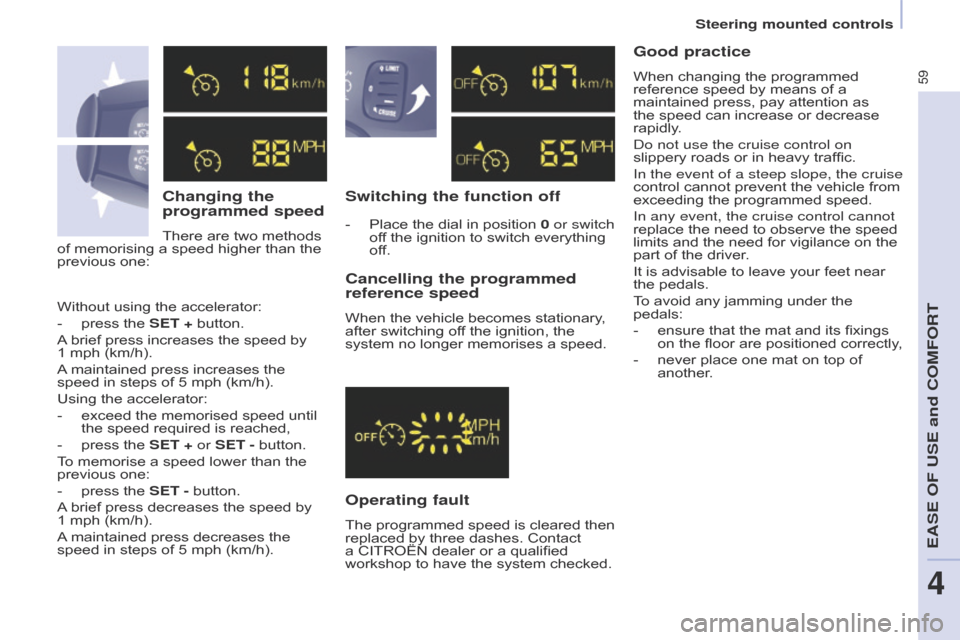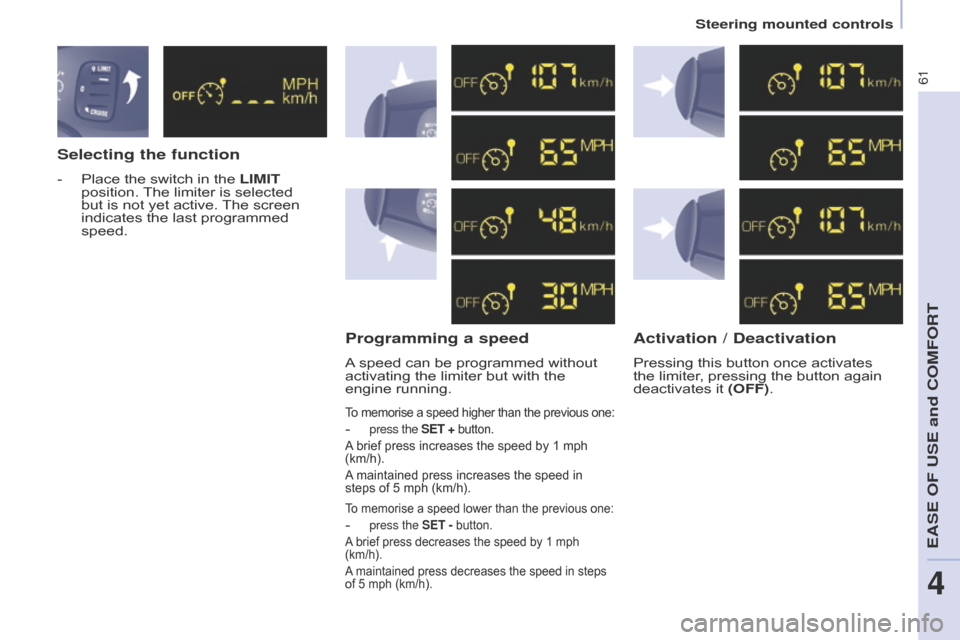2014.5 Citroen BERLINGO steering
[x] Cancel search: steeringPage 61 of 244

59
Berlingo-2-VU_en_Chap04_Ergonomie_ed02-2014
Changing the
programmed speed
There are two methods
of memorising a speed higher than the
previous one:
Switching the function off
Operating fault
The programmed speed is cleared then
replaced by three dashes. Contact
a CITROËN dealer or a qualified
workshop to have the system checked.
Cancelling the programmed
reference speed
When the vehicle becomes stationary,
after switching off the ignition, the
system no longer memorises a speed.
Without using the accelerator:
-
press the
SET + button.
A brief press increases the speed by
1 mph (km/h).
A maintained press increases the
speed in steps of 5 mph (km/h).
Using the accelerator:
-
exceed the memorised speed until
the speed required is reached,
-
press the
SET + or SET - button.
To memorise a speed lower than the
previous one:
-
press the
SET - button.
A brief press decreases the speed by
1 mph (km/h).
A maintained press decreases the
speed in steps of 5 mph (km/h). -
Place the dial in position
0 or switch
off the ignition to switch everything
off.
Good practice
When changing the programmed
reference speed by means of a
maintained press, pay attention as
the speed can increase or decrease
rapidly.
d
o not use the cruise control on
slippery roads or in heavy traffic.
In the event of a steep slope, the cruise
control cannot prevent the vehicle from
exceeding the programmed speed.
In any event, the cruise control cannot
replace the need to observe the speed
limits and the need for vigilance on the
part of the driver.
It is advisable to leave your feet near
the pedals.
To avoid any jamming under the
pedals:
-
ensure that the mat and its fixings
on the floor are positioned correctly
,
-
never place one mat on top of
another
.
Steering mounted controls
EASE OF USE and COMFORT
4
Page 62 of 244

60
Berlingo-2-VU_en_Chap04_Ergonomie_ed02-2014
However, pressing the pedal beyond
this point of resistance to the floor
allows the programmed speed to be
exceeded. To resume use of the limiter,
simply reduce the pressure on the
accelerator pedal gradually and return
to a speed below that programmed.
The operating actions may be
carried out when stationary, with the
engine running, or with the vehicle
moving.This speed limiter shows the function
selection status in the instrument panel
and displays the programmed speed:
SPEED LIMITER "LIMIT"
Function selected,
displaying of the
"Speed Limiter"
symbol.
Function deactivated,
last programmed
speed - OFF
Function activated
Vehicle speed above
the programmed
speed, which is
displayed flashing.
Operating fault
detected,
OFF - the dashes
flash.
"This is the selected speed which the
driver does not wish to exceed".
This selection is made with the engine
running while stationary or with the
vehicle moving. The minimum speed
which can be programmed is 20 mph
(30 km/h).
The speed of the vehicle responds
to the pressure of the driver's foot as
far as the accelerator pedal point of
resistance which indicates that the
programmed speed has been reached.
Steering mounted controls
Page 63 of 244

61
Berlingo-2-VU_en_Chap04_Ergonomie_ed02-2014
Selecting the function
- Place the switch in the LIMIT
position. The limiter is selected
but is not yet active. The screen
indicates the last programmed
speed.
Programming a speed
A speed can be programmed without
activating the limiter but with the
engine running.
Activation / Deactivation
Pressing this button once activates
the limiter, pressing the button again
deactivates it (OFF).
To memorise a speed higher than the previous one:
- press the SET + button.
A brief press increases the speed by 1 mph
(km/h).
A maintained press increases the speed in
steps of 5 mph (km/h).
To memorise a speed lower than the previous one:
- press the SET - button.
A brief press decreases the speed by 1 mph
(km/h).
A maintained press decreases the speed in steps
of 5 mph (km/h).
Steering mounted controls
EASE OF USE and COMFORT
4
Page 64 of 244

62
Berlingo-2-VU_en_Chap04_Ergonomie_ed02-2014
Exceeding the programmed
speed
Pressing the accelerator pedal in order
to exceed the programmed speed
will have no effect unless you press
the pedal firmly beyond the point of
resistance.
The limiter is deactivated temporarily
and the programmed speed flashes
accompanied by an audible signal.
To return to the limiter function, reduce
your speed to below the programmed
speed.Switching the function off
- Place the switch in position 0 or
switch off the ignition to switch the
system off.
The last programmed speed remains in
the memory.
Operating fault
The programmed speed is cleared
then replaced by three dashes.
Contact a CITROËN dealer or a
qualified workshop to have the system
checked.
Good practice
Flashing of the speed
The speed flashes:
-
following forcing of the accelerator
point of resistance,
-
when the limiter cannot prevent an
increase in the vehicle speed due
to the profile of the road or on a
steep descent,
-
in the event of sharp acceleration. In any event, the speed limiter cannot
replace the need to observe speed
limits, nor can it replace the need for
vigilance on the part of the driver
.
Always pay attention to the profile
of the road and sharp acceleration
and stay in complete control of your
vehicle.
To avoid any jamming under the
pedals:
-
ensure that the mat and its fixings
on the floor are positioned correctly
,
-
never place one mat on top of
another
.
Steering mounted controls
Page 76 of 244

74
Berlingo-2-VU_en_Chap04_Ergonomie_ed02-2014
FRONT FITTINGS1. Lower glove box
This may or may not be fitted with a lid.
Upper storage compartment
This is located on the dashboard,
behind the steering wheel.
A recess makes lifting of the lid easier
when opening. Guide it to its rest
position.
To close, guide the lid then press the
centre gently.
Any liquid which could spill risks
causing an electrical short circuit and
therefore a potential fire.
3. Side storage compartment
4. Bag hook
Only hang flexible bags which are not
too heavy on this hook.
2. Storage pocket and bottle
holder (1.5 L)
Practical information
Page 87 of 244

85
Berlingo-2-VU_en_Chap05_Securite_ed02-2014
HAZARD WARNING LAMPS
HORN
Press the centre of the steering wheel.
PARKING BRAKE
Applying
Pull the parking brake lever up to
immobilise your vehicle.
Check that the parking brake is applied
firmly before leaving the vehicle.Pull on the parking brake lever, only
with the vehicle stationary.
In the exceptional case of use of the
parking brake when the vehicle is
moving, apply the brake by pulling
gently to avoid locking the rear wheels
(risk of skidding).
Press this button, the direction
indicators flash.
They can operate with the ignition off.
The hazard warning lamps should only
be used in dangerous situations, when
stopping in an emergency or when
driving in unusual conditions.
When parking on a slope, direct your
wheels towards the pavement and pull
the parking brake lever up.
There is no advantage in engaging
a gear after parking the vehicle,
particularly if the vehicle is loaded.
If the parking brake is still on or has
not been released properly, this is
indicated by this warning lamp which
comes on on the instrument panel.
Automatic operation of hazard
warning lamps
When braking in an emergency,
depending on the force of deceleration,
the hazard warning lamps come
on automatically. They switch off
automatically the first time you
accelerate.
It is also possible to switch them off by
pressing the switch on the dashboard.Releasing
Pull the lever and press the button to
lower the parking brake lever.
Driving safely
SAFETY
5
Page 97 of 244

95
Berlingo-2-VU_en_Chap05_Securite_ed02-2014
Good practice
Sit in a normal upright position.
Wear a correctly adjusted seat belt.
Do not leave anything between the
occupants and the airbags (a child,
pet, object...). This could hinder the
operation of the airbags or injure the
occupants.
After an accident or if the vehicle has
been stolen or broken into, have the
airbag systems checked.
All work on the airbag system is strictly
forbidden unless it is carried out by
qualified personnel at a CITROËN
dealer or a qualified workshop.
Even if all of the precautions
mentioned are observed, a risk of
injury or of minor burns to the head,
chest or arms when an airbag is
deployed cannot be ruled out. In fact,
the bag inflates almost instantly (within
a few milliseconds) then deflates within
the same time discharging the hot gas
via openings provided for this purpose.Lateral airbags
Only put recommended covers on
the seats. These will not hinder
inflation of the lateral airbags. Contact
a CITROËN dealer or a qualified
workshop.
Do not fix or attach anything to the seat
backs. This could cause injury to the
chest or arms when the lateral airbag
inflates.
d
o not sit with the upper part of the
body any nearer to the door than
necessary.
Front airbags
Do not drive holding the steering wheel
by its spokes or resting your hands on
the centre part of the wheel.
Do not allow passengers to place
their feet on the dashboard, they risk
serious injury if the airbag is deployed.
Smoke as little as possible as
deployment of the airbags can cause
burns or the risk of injury from a
cigarette or pipe.
Never remove or pierce the steering
wheel or hit it violently.
Airbags only operate when the
ignition is switched on.
This equipment only operates once.
If a second impact occurs (during the
same or a subsequent accident), the
airbag will not operate.
The deployment of an airbag or airbags
is accompanied by a slight discharge
of smoke and a noise, due to the
activation of the pyrotechnic cartridge
incorporated in the system.
This smoke is not harmful, but
sensitive individuals may experience
some irritation.
The noise of the detonation may result
in a slight loss of hearing for a short
time.
The passenger's front airbag must
be deactivated if a child seat is
installed facing rearward.
Chapter 5, "Children on board"
section.
Airbags
SAFETY
5
Page 99 of 244

97
Berlingo-2-VU_en_Chap05_Securite_ed02-2014
Front airbags
The front airbags are fitted in the
centre of the steering wheel for the
driver and in the dashboard for the
front passenger(s).
Deployment
They are deployed, except the
passenger's front airbag if it has been
deactivated, in the event of a serious
front impact applied to all or part of the
front impact zone A in the longitudinal
centreline of the vehicle on a horizontal
plane directed from the front towards
the rear of the vehicle.
The front airbag inflates between the
front occupant of the vehicle and the
dashboard to cushion their forward
movement.Deactivation
Only the passenger's front airbag can
be deactivated:
-
with the ignition switched off
,
insert the key into the passenger's
front airbag deactivation switch,
-
turn it to the
"OFF" position,
-
then remove the key keeping the
switch in the new position.The passenger's front airbag
warning lamp in the instrument
panel remains on while the
airbag is deactivated. If the two airbag warning lamps
are on continuously, do not install
a rearward facing child seat and
contact a CITROËN dealer or a
qualified workshop.
Front airbag fault
To ensure the safety of your child,
it is essential to deactivate the
passenger's front airbag when you
install a rearward facing child seat on
the front passenger seat. Otherwise,
the child would risk being killed or
seriously injured if the airbag were
deployed. Reactivation
In the "OFF" position, the passenger's
front airbag will not be deployed in the
event of an impact.
As soon as the child seat is removed,
turn the passenger's front airbag switch
to the "ON" position to reactivate the
airbag and thus ensure the safety
of your passenger in the event of an
impact.
If this warning lamp comes
on, accompanied by an
audible signal and a message
in the screen, consult a
CITROËN dealer or a
qualified workshop to have
the system checked.
Airbags
SAFETY
5